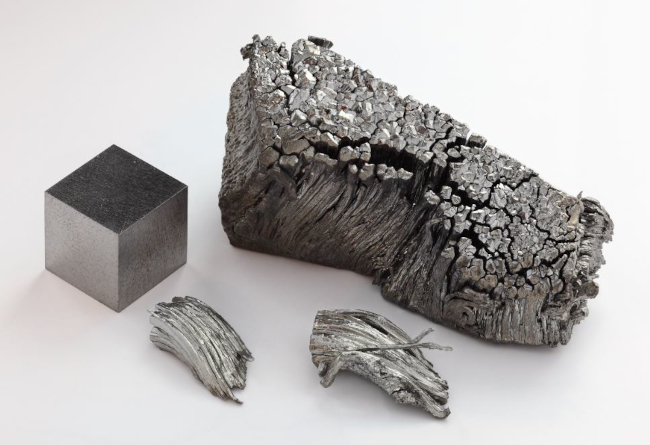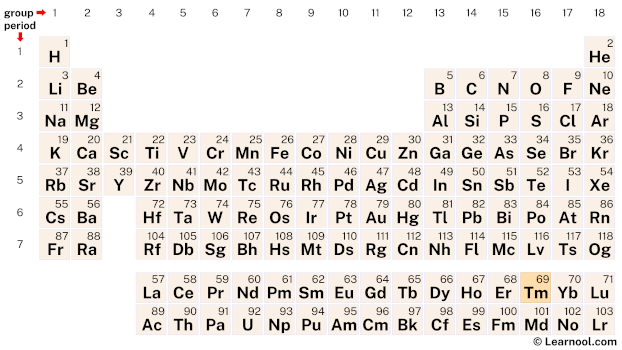
Thulium (Tm) is a chemical element of the periodic table, located in the period 6, and has the atomic number 69. It is the thirteenth element in the lanthanide series. It is a bright, silvery-gray metal, whose name comes from “Thule”, the ancient name for Scandinavia. It is not available freely in nature and is counted as one of the rare earth elements.
On periodic table
| group | ⇨ | 1 | 2 | 3 | 4 | 5 | 6 | 7 | 8 | 9 | 10 | 11 | 12 | 13 | 14 | 15 | 16 | 17 | 18 |
| period | ⇩ | ||||||||||||||||||
| 1 | 1 H  Hydrogen |
2 He  Helium |
|||||||||||||||||
| 2 | 3 Li  Lithium |
4 Be  Beryllium |
5 B  Boron |
6 C  Carbon |
7 N  Nitrogen |
8 O  Oxygen |
9 F  Fluorine |
10 Ne  Neon |
|||||||||||
| 3 | 11 Na  Sodium |
12 Mg  Magnesium |
13 Al  Aluminium |
14 Si Silicon |
15 P  Phosphorus |
16 S  Sulfur |
17 Cl  Chlorine |
18 Ar  Argon |
|||||||||||
| 4 | 19 K  Potassium |
20 Ca  Calcium |
21 Sc  Scandium |
22 Ti  Titanium |
23 V  Vanadium |
24 Cr  Chromium |
25 Mn  Manganese |
26 Fe  Iron |
27 Co  Cobalt |
28 Ni  Nickel |
29 Cu  Copper |
30 Zn  Zinc |
31 Ga  Gallium |
32 Ge  Germanium |
33 As  Arsenic |
34 Se  Selenium |
35 Br  Bromine |
36 Kr  Krypton |
|
| 5 | 37 Rb  Rubidium |
38 Sr  Strontium |
39 Y  Yttrium |
40 Zr  Zirconium |
41 Nb  Niobium |
42 Mo  Molybdenum |
43 Tc  Technetium |
44 Ru  Ruthenium |
45 Rh  Rhodium |
46 Pd  Palladium |
47 Ag  Silver |
48 Cd  Cadmium |
49 In  Indium |
50 Sn  Tin |
51 Sb  Antimony |
52 Te  Tellurium |
53 I  Iodine |
54 Xe  Xenon |
|
| 6 | 55 Cs  Caesium |
56 Ba  Barium |
72 Hf  Hafnium |
73 Ta  Tantalum |
74 W  Tungsten |
75 Re  Rhenium |
76 Os  Osmium |
77 Ir  Iridium |
78 Pt  Platinum |
79 Au  Gold |
80 Hg  Mercury |
81 Tl  Thallium |
82 Pb  Lead |
83 Bi  Bismuth |
84 Po  Polonium |
85 At  Astatine |
86 Rn  Radon |
||
| 7 | 87 Fr  Francium |
88 Ra  Radium |
104 Rf  Rutherfordium |
105 Db  Dubnium |
106 Sg  Seaborgium |
107 Bh  Bohrium |
108 Hs  Hassium |
109 Mt  Meitnerium |
110 Ds  Darmstadtium |
111 Rg  Roentgenium |
112 Cn  Copernicium |
113 Nh  Nihonium |
114 Fl  Flerovium |
115 Mc  Moscovium |
116 Lv  Livermorium |
117 Ts  Tennessine |
118 Og  Oganesson |
||
| 57 La  Lanthanum |
58 Ce  Cerium |
59 Pr  Praseodymium |
60 Nd  Neodymium |
61 Pm  Promethium |
62 Sm  Samarium |
63 Eu  Europium |
64 Gd  Gadolinium |
65 Tb  Terbium |
66 Dy  Dysprosium |
67 Ho  Holmium |
68 Er  Erbium |
69 Tm Thulium |
70 Yb  Ytterbium |
71 Lu  Lutetium |
|||||
| 89 Ac  Actinium |
90 Th  Thorium |
91 Pa  Protactinium |
92 U  Uranium |
93 Np  Neptunium |
94 Pu  Plutonium |
95 Am  Americium |
96 Cm  Curium |
97 Bk  Berkelium |
98 Cf  Californium |
99 Es  Einsteinium |
100 Fm  Fermium |
101 Md  Mendelevium |
102 No  Nobelium |
103 Lr  Lawrencium |
|||||
| – f block |
Thulium (Tm) is located on the periodic table in the lanthanide series, which is a group of elements located at the bottom of the table. Specifically, in period 6, between erbium (Er) and ytterbium (Yb).
Element information
 |
|
 |
|
| Origin of name | name comes from Thule, the ancient name for Scandinavia |
| Symbol | Tm |
| Atomic number (Z) | 69 |
| Atomic mass | 168.93421 u |
| Block | f-block |
| Period | 6 |
| Classification | Lanthanide |
| Atomic radius | 176 pm |
| Covalent radius | 190±10 pm |
| Melting point | 1545 ℃, 2813 ℉, 1818 K |
| Boiling point | 1950 ℃, 3542 ℉, 2223 K |
| Electron configuration | [Xe] 4f13 6s2 |
| Learn how to write: Thulium electron configuration | |
| Electrons per shell | 2, 8, 18, 31, 8, 2 |
| Crystal structure | Hexagonal close-packed (hcp) |
| Phase at r.t | Solid |
| Density near r.t | 9.32 g/cm3 |
| Main isotopes | Thulium-169 |
| Natural occurrence | Primordial |
| Oxidation state | +3 |
| Electronegativity (Pauling scale) | 1.25 |
| Protons Neutrons Electrons |
69 100 69 |
| CAS number | 7440-30-4 |
| Discovered by | Per Teodor Cleve in 1879 |
History

Thulium was discovered in 1879 by the Swedish chemist Per Teodor Cleve. Cleve was analyzing the mineral erbia, which is primarily composed of erbium oxide, and observed that a new substance was present in the sample. He named the new element thulium after the ancient name for Scandinavia, Thule. Thulium was the last of the rare earth elements to be discovered, and its discovery completed the series of 15 elements from lanthanum to lutetium. The development of spectroscopic techniques in the late 19th century was crucial to the discovery of thulium and the other rare earth elements, as it allowed scientists to distinguish between the different elements based on the unique spectra they produced. Thulium is still relatively rare and not widely used, but its unique properties make it an important element for certain applications.
Occurrence and production
Thulium is a rare earth element that is relatively abundant in the earth’s crust. It is found in several minerals such as monazite, xenotime, and euxenite. Monazite sands, which are rich in rare earth elements including thulium, are the primary source for thulium production. Thulium can be extracted from these minerals using a process called ion exchange or solvent extraction. The process involves extracting rare earth elements using an organic solvent that selectively binds with specific rare earth elements. Once extracted, the thulium is then purified using several refining techniques including precipitation, ion exchange, and fractional crystallization. Thulium is a rare earth element and is therefore difficult and expensive to produce. The annual worldwide production of thulium is estimated to be around 50 to 60 tonnes per year.
Properties
Thulium is the second least abundant of the rare earth elements, with an abundance in the Earth’s crust estimated to be about 0.5 parts per million.
It is a relatively soft metal, with a hardness similar to that of lead.
Thulium has a melting point of 1545 ℃ (2813 ℉) and a boiling point of 1950 ℃ (3542 ℉).
It has a high electrical resistivity, making it useful for certain types of electrical components.
Thulium has the highest magnetic moment of any naturally occurring element, which makes it useful for magnetic resonance imaging (MRI) and other medical applications.
It has a unique fluorescence spectrum that makes it useful in fiber-optic amplifiers, which are used in telecommunications.
Applications
Nuclear energy
Thulium-170 is used as a neutron source in nuclear reactors for research purposes. When thulium-170 is bombarded with neutrons, it produces a radioactive isotope that can be used for imaging and radiation therapy in medical applications.
Fiber optic amplifiers
Thulium-doped fiber optic amplifiers are used in telecommunications for signal amplification over long distances. These amplifiers can boost the power of optical signals traveling through fiber optic cables, allowing for faster and more reliable communication.
Portable X-ray machines
Thulium is used as a radiation source in portable X-ray machines, which are commonly used in the field by doctors, veterinarians, and other healthcare professionals. These machines can be particularly useful in remote or underserved areas, where access to traditional X-ray equipment may be limited.
High-temperature superconductors
Thulium is used in high-temperature superconductors, which have important applications in fields such as energy storage and transportation. Superconductors made with thulium can conduct electricity with zero resistance at higher temperatures than other materials, making them more practical for use in real-world applications.
Magnets
Thulium is used to create high-strength magnets that have applications in fields such as aerospace and defense. These magnets can be used in motors, generators, and other devices that require strong magnetic fields.
Interesting facts
Thulium is named after the ancient city of Thule in Scandinavia, which is believed to be located in modern-day Norway.
Thulium is one of the least abundant rare earth elements, with an abundance in the Earth’s crust of about 0.5 parts per million.
Thulium has a relatively low melting point of 1545 ℃, which is the second-lowest of all the rare earth metals after europium.
Thulium is the second-least reactive of all the rare earth metals, after lutetium.
Thulium emits X-rays when exposed to gamma rays, which makes it useful for medical imaging and radiation therapy.
Thulium has the highest magnetic moment of all the rare earth elements, which makes it useful for making magnets.
Thulium-doped fibers are used in high-power fiber optic amplifiers, which are used to boost the signal strength of long-distance communication cables.
Related
More elements
External links
- https://www.rsc.org/periodic-table/element/69/thulium
- https://www.britannica.com/science/thulium
- https://en.wikipedia.org/wiki/Thulium
- https://www.chemicool.com/elements/thulium.html
- https://pubchem.ncbi.nlm.nih.gov/element/Thulium
Deep
Learnool.com was founded by Deep Rana, who is a mechanical engineer by profession and a blogger by passion. He has a good conceptual knowledge on different educational topics and he provides the same on this website. He loves to learn something new everyday and believes that the best utilization of free time is developing a new skill.
